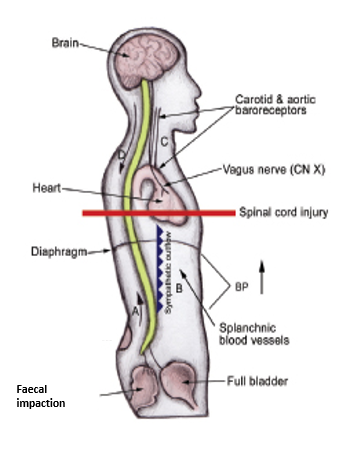Autonomic Dysreflexia
7 Items
Exercise and SCI
3 Items
Bladder and Bowel Management
7 Items
Your skin after SCI
5 Items
Support for Family & Friends
3 Items
Growing up with SCI
3 Items
What to do if AD is suspected
 Autonomic dysreflexia (AD) is a potentially life-threatening medical emergency:
Autonomic dysreflexia (AD) is a potentially life-threatening medical emergency:
- AD can occur in patients with spinal cord injury at or above the 6th thoracic vertebra (T6).
- It is more likely to occur in patients with complete injuries, but incomplete injured patients can also be at risk.
- The condition is triggered by a painful stimulus below the level of the injury which causes severe, sudden hypertension (raised blood pressure),
and if left untreated can be harmful - For most people, AD can be easily treated as well as prevented.
The key is knowing your baseline blood pressure, triggers and symptoms.
NOTE: Medications are generally used only if the offending trigger/stimulus cannot be identified and removed – or when an episode persists even after removal of the suspected cause.
What to do if AD is suspected:
- Most importantly, locate and remove the offending stimulus, if possible.
Early recognition of the condition is essential so that treatment can be started immediately. - Begin by looking for your most common causes: bladder, bowel, tight clothing, skin issues.
- Most importantly, locate and remove the offending stimulus, if possible.
NOTE: Keep in mind that when you remove the cause, your AD may get worse before it gets better.
Then follow these steps:
- Sit up or raise your head to 90 degrees
If you can lower your legs, do so - Loosen or remove anything tight
- Treat the cause
- Not everyone has access to a blood pressure (B/P) machine but if you can, check blood pressure every five minutes.
NOTE: It is more important to treat the cause first when you are dysreflexic, than trying to get a blood pressure reading.
In adults with a cervical level (neck) injury who often have low blood pressure, a rise in systolic (upper) blood pressure of 20 – 40mmHg (which may bring your B/P within the normal range) may indicate AD.
For other patients a systolic (upper) B/P of 150mmHg or more is an indicator of AD.
Make sure you know YOUR normal resting blood pressure (see below*) - Stay sitting up until blood pressure is normal
- Sit up or raise your head to 90 degrees
Seek prompt medical advice if the cause cannot be identified, or the hypertension cannot be controlled.
Tell the doctors and nurses/paramedics/ambulance crew that you:
- may have Autonomic dysreflexia (AD)
- need to find what’s causing it
- need to have your blood pressure checked
- need to stay sitting up
NOTE: If the hypertension is severe, or the cause still cannot be identified, you will need to be treated with medication.
Medications are generally used only if the offending trigger/stimulus cannot be identified and removed – or when an episode persists even after removal of the suspected cause.


